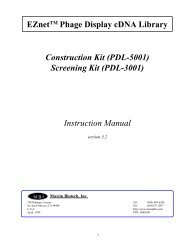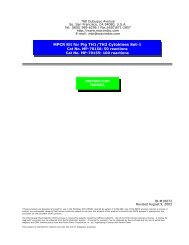MP-70045 - Maxim Biotech, Inc.
MP-70045 - Maxim Biotech, Inc.
MP-70045 - Maxim Biotech, Inc.
Create successful ePaper yourself
Turn your PDF publications into a flip-book with our unique Google optimized e-Paper software.
780 Dubuque Avenue<br />
So. San Francisco, CA 94080, U.S.A.<br />
Tel: (800) 989-6296 / Fax:(650)871-2857<br />
http://www.maximbio.com<br />
E-mail: mbi@maximbio.com<br />
<strong>MP</strong>CR Kit for Human Chemokine Receptors CXCR Set-1<br />
Cat No. <strong>MP</strong>-70046: 50 reactions<br />
Cat No. <strong>MP</strong>-<strong>70045</strong>: 100 reactions<br />
INSTRUCTION<br />
MANUAL<br />
*These products are designed and sold for use in the Multiplex PCR (<strong>MP</strong>CR) covered by patent # 5,582,989. Use of the <strong>MP</strong>CR process requires a license. A<br />
limited, non-automated research field license under the patent to use only this amount of the product to practice the <strong>MP</strong>CR process is conveyed to the<br />
purchaser by the purchase of this product.<br />
The Polymerase Chain Reaction (PCR) process is covered by patents owned by Hoffman-LaRoche. Use of the PCR process requires a license. A license for<br />
diagnostic purposes may be obtained from Roche Molecular System. A license for research may be obtained by the purchase and the use of authorized<br />
reagents and DNA thermocyclers from the Perkin-Elmer Corporation or by negotiating a license with Perkin-Elmer.<br />
This product is intended for research use only and not for diagnostic purposes.<br />
ID-M10008<br />
Revised February 7, 2003
INTRODUCTION<br />
Chemokines & their receptors are important elements<br />
for the activation and selective attraction of various subsets<br />
of leukocytes, and play a critical role in controlling the movement<br />
of these cells during inflammation (1,2,3,4). Evidence<br />
gathered during past few years suggests an important role<br />
for chemokines in a variety of pathophysiological processes<br />
(e.g., chronic and acute inflammation, infectious diseases,<br />
modulation of angiogenesis, tumor growth, and hematopoietic<br />
progenitor cell proliferation). The most notable of these<br />
recent discoveries is that certain chemokine receptors function<br />
as co-receptors for HIV-1. Moreover, mutations in these<br />
receptors can result in host resistance to infection and also<br />
effect the progression of disease course (5, 6, 7).<br />
Chemokines have molecular masses of 8-10 kDa and<br />
show approximately 20-50 percent sequence homology<br />
among each other at the protein level. The proteins also<br />
share common gene structures and tertiary structures. All<br />
chemokines possess a number of conserved cysteine residues<br />
involved in intramolecular disulfide bond formation.<br />
According to the chromosomal locations of individual<br />
genes, two different subfamilies of chemokines are distinguished.<br />
In members of Alpha-Chemokines, the first two<br />
cysteine residues are separated by a single amino acid and<br />
thus are also called C-X-C-Chemokines. In members of<br />
Beta-Chemokines, the first two cysteine residues of this family<br />
are adjacent, and thus, are also called C-C-C-Chemokines.<br />
The C-Chemokines or Gamma-Chemokines differ from the<br />
other chemokines by the absence of a cysteine residue.<br />
Members of the small group of chemokines with a CX(3)C<br />
cysteine signature motif are referred to as Delat-Chemokines<br />
or CX3C-Chemokines. The existence of clearly defined subgroups<br />
of chemokines on the basis of structural and functional<br />
properties illustrates the importance of<br />
chemoattractant diversity in the regulation of leukocyte are<br />
designated CXCR followed by a number (i.e. CXCR-1, CXCR-<br />
2, CXCR-3, CXCR-4, CXCR-5) while those that bind C-C-<br />
Chemokines are designated CCR followed by a number (i.e.<br />
CCR-1, CCR-2, CCR-3, CCR-4, CCR-5, CCR-6, CCR-7, CCR-<br />
8, CCR-9, CCR-10).<br />
Analysis of the temporal and spatial distribution of<br />
RNA expression provides researchers with important clues<br />
about the function of apoptosis regulating genes in their<br />
own systems. Northern Blot and RNase Protection Assay<br />
are the most widely used procedures for determining the<br />
abundance of a specific mRNA in a total or poly(A) RNA<br />
sample. RT-<strong>MP</strong>CR provides an alternate and accurate method<br />
to detect multiple gene expression by amplifying all the genes<br />
under the same conditions (8, 9, 10). Variations in RNA<br />
isolation, initial quantitation errors or tube-to-tube variations<br />
in RT and PCR can be compensated by including a<br />
house-keeping gene, such as GAPDH, in <strong>MP</strong>CR. Alternatively,<br />
a parallel RT-PCR using the same cDNA, PCR conditions<br />
and primers for one of house-keeping genes may be<br />
run to offset any variations. Differences in gene expression<br />
can be determined by normalizing its expression against<br />
GAPDH expression.<br />
<strong>Maxim</strong>'s hCXC1G-<strong>MP</strong>CR kits have been designed to<br />
detect the expression of human CXCR1&2, CXCR3, CXCR4,<br />
SDF-1a and GAPDH genes. The PCR primers have similar<br />
Tm and no obvious 3'-end overlap to enhance multiple amplification<br />
in a single tube. The Kit will yield 500 bp(GAPDH),<br />
400 bp(SDF-1a), 301 bp(CXCR-3), 248 bp(CXCR-4) and 191<br />
bp(CXCR-1&2) PCR products with RNA from human cells or<br />
positive controls from kit. The gene expression of these<br />
genes can be analyzed and compared with GAPDH gene<br />
expression.<br />
2
PCR PRODUCT QUANTITATION<br />
I: Radioactive Quantitation<br />
In our experience, visual inspection of an EtBr-stained<br />
agarose gel is sensitive and precise enough to detect changes<br />
as low as two-fold. If greater discrimination is necessary,<br />
several methods are available. The simplest procedure is to<br />
add a radioactively labeled dNTP to the PCR reaction. After<br />
gel analysis, the band may be excised and counted in a<br />
scintillation counter. Alternatively the gel may be dried and<br />
an autoradio-gram may be generated which can be scanned<br />
in a densitometer. Another method is to label the 5’ end of<br />
one or both of the primers with 32 P, which is incorporated<br />
into the PCR products and then assayed for radioactivity<br />
(12).<br />
Southern blot hybridization with synthetic DNA probes<br />
may also be performed to verify and quantitate PCR generated<br />
products, either by densitometry of an autoradiogram<br />
or by excising and counting the signal from a hybridization<br />
membrane. This method also quantitates only the target<br />
product without interference from nontarget products or<br />
primer-generated artifacts.<br />
II: Non-Radioactive Quantitation<br />
Nonradioactive quantitation methods include the use<br />
of biotinylated or digoxygenin-labeled primers in conjunction<br />
with the appropriate detection methods (13), use of a<br />
bioanalyzer or WAVE. For an in-depth discussion of the various<br />
methods of PCR product quantitation, refer to the review<br />
article by Bloch (14).<br />
In addition to the above methods, several companies<br />
now offer gel video systems which can scan and quantitate<br />
EtBr-stained gel bands in much the same way a densitometer<br />
does. Lab-on-a-chip (BioAnalyzer), CE, HPLC, and WAVE<br />
may also be used to analyze <strong>MP</strong>CR products and quantitate<br />
simultaneously.<br />
CO<strong>MP</strong>ARISON OF <strong>MP</strong>CR WITH RPA<br />
<strong>MP</strong>CR<br />
(Multiplex Polymerase Chain Reaction)<br />
√ Non-isotope method with high sensitivity<br />
0.1-1µg total RNA per <strong>MP</strong>CR<br />
√ Whole process takes only a few hours<br />
√ Detect Multiple Genes Simultaneously &<br />
Quantitatively<br />
√ Signal can be quantified directly from gel<br />
if isotope is included in <strong>MP</strong>CR. Additional<br />
techniques can be used to quantify <strong>MP</strong>CR<br />
product (using Bioanalyzer, HPLC, and WAVE.)<br />
√ Non-specific products can be eliminated by using<br />
probes and southern hybridization.<br />
√ Ready-to-use<br />
RPA<br />
(RNase Protection Assay)<br />
√ Isotope or Non-Isotope methods<br />
1-20 µg total RNA per RPA assay<br />
√ Whole process takes two days<br />
√ Detect Multiple Genes Simultaneously &<br />
Quantitatively<br />
√ Signal can be quantified directly from gel<br />
√ Non-specific signal can be generated<br />
by either low stringent conditions or<br />
high-secondary-structure template.<br />
√ Make own "hot" RNA probes<br />
3
<strong>MP</strong>CR KIT DESCRIPTION<br />
<strong>MP</strong>CR Amplification Kits include all necessary <strong>MP</strong>CR<br />
amplification reagents with the exception of Taq Polymerase.<br />
These kits have been designed to direct the simultaneous<br />
amplification of specific regions of human DNA.<br />
Figure 1<br />
N M 1 2 3 4 5 6<br />
<strong>MP</strong>CR Kits come in two quantities:<br />
• 50X 50µL reaction kits<br />
• 100X 50µL reaction kits<br />
Each kit offers <strong>Maxim</strong>’s optimal primer/buffer system<br />
which will enhance amplification specificity.<br />
Figure 1 shows quality control <strong>MP</strong>CR results obtained<br />
by following <strong>MP</strong>CR kit manual using different concentrations<br />
of positive control.<br />
For optimal results, please read and follow the instructions<br />
in this manual carefully. If you have any questions,<br />
please contact <strong>Maxim</strong> <strong>Biotech</strong> Customer Service at<br />
(650) 871-1919.<br />
Lane N: PCR using hCXC1G Primers without<br />
positive (Negative)<br />
Lane 1: PCR using hCXC1G Primers<br />
Lane 2: PCR using Human GAPDH Primers<br />
Lane 3: PCR using Human SDF-1alpha Primers<br />
Lane 4: PCR using Human CXCR3 Primers<br />
Lane 5: PCR using Human CXCR4 Primers<br />
Lane 6: PCR using Human CXCR1&2 Primers<br />
Lane M: DNA M.W. Marker<br />
<strong>MP</strong>CR PRIMER INFORMATION<br />
Product Gene 5’/3’ Tm Amplicon Accession Intron Genomic<br />
Code Size No. Span Size<br />
hCXC1G-CXC1 Human CXCR1&2 66 o C/66 o C 191bp M68932(CXCR1) no 191bp<br />
L19593(CXCR2)<br />
hCXC1G-CXC3 Human CXCR3 70 o C/72 o C 301bp X95876 no 301bp<br />
hCXC1G-CXC4 Human CXCR4 68 o C/69 o C 248bp X71635 no 248bp<br />
hCXC1G-SDF Human SDF-1a 67 o C/71 o C 400bp L36034 yes 2437bp<br />
hCXC1G-GAP Human GAPDH 62 o C/63 o C 500bp M33197 yes 2533bp<br />
4
KIT CO<strong>MP</strong>ONENTS<br />
Product Code Kit Component Amount<br />
<strong>MP</strong>-70046<br />
50X50µL <strong>MP</strong>CR reaction kit<br />
Store all reagents at -20°C<br />
hCXC1G-B001 2X hCXC1G <strong>MP</strong>CR Buffer 1250 µl<br />
(containing chemicals, enhancer,<br />
stabilizer and dNTPs)<br />
hCXC1G-C001 10X hCXC1G <strong>MP</strong>CR Pos. Control 50µl<br />
hCXC1G-P001 10X hCXC1G <strong>MP</strong>CR Primers 250µl<br />
MRB-0014 DNA M.W. Marker (100bp Ladder) 100 µl<br />
MRB-0011P ddH 2<br />
0 (DNase free) 2.0 ml<br />
Instruction Manual<br />
Product Code Kit Component Amount<br />
<strong>MP</strong>-<strong>70045</strong><br />
100X50µL <strong>MP</strong>CR reaction kit<br />
Store all reagents at -20°C<br />
hCXC1G-B001 2X hCXC1G <strong>MP</strong>CR Buffer 1250µl X2<br />
(containing chemicals, enhancer,<br />
stabilizer and dNTPs)<br />
hCXC1G-C001 10X hCXC1G <strong>MP</strong>CR Pos. Control 50µl X2<br />
hCXC1G-P001 10X hCXC1G <strong>MP</strong>CR Primers 250µl X2<br />
MRB-0014 DNA M.W. Marker (100bp Ladder) 100 µl X2<br />
MRB-0011P ddH 2<br />
0 (DNase free) 2.0 ml X2<br />
Instruction Manual<br />
NOTE: SPIN ALL TUBES BEFORE USING AND VORTEX ALL<br />
REAGENTS FOR AT LEAST 15 SECONDS BEFORE USING !!<br />
5
PROCEDURE<br />
RT Protocol:<br />
The isolation of undegraded, intact RNA is an essential prerequisite for successful first strand synthesis and<br />
PCR amplification. Care should be taken to avoid RNase contamination of buffers and containers used for<br />
RNA work by pretreating with DEPC, autoclaving, and baking. Always wear sterile gloves when handling<br />
reagents. Use cDNA derived from 10 5 cells (1µg cDNA) and apply them to each <strong>MP</strong>CR reaction.<br />
1. Prepare total RNA, mRNA or use the control GAPDH RNA which is provided in <strong>Maxim</strong>'s <strong>MP</strong>CR kit. NOTE: It<br />
is best to use cDNA derived from 0.5-1 x 10 5 cells ( 0.5-1µg cDNA derived from RNA) for each <strong>MP</strong>CR reaction.<br />
2. Equilibrate 3 water baths: 37°C, 70°C and 95°C.<br />
3. On ice, pipet 1-2 µg mRNA or 10 µg total RNA (from 10 6 cells) dissolved in pure water or 2 µl control GAPDH<br />
RNA into a RNAase free reaction vial. We strongly recommend including a positive control reaction when<br />
setting up an RT-PCR reaction for the first time.<br />
4. Add sterile water to a final volume of 14.5 µl.<br />
5. Add 4 µl random hexamer (50 mM) or Oligo(dT) (50 mM).<br />
NOTE: The hexamer and Oligo(dT) RT reactions may be run simultaneously.<br />
6. <strong>Inc</strong>ubate tube(s) at 70°C for 5 minutes and quickly chill on ice.<br />
7. Begin your RT reaction by adding the following reagents to your hexamer or Oligo mixture:<br />
Reagent Description Volume per Reaction<br />
RNase Inhibitor 130U/µl 0.5µl<br />
5 X RT buffer 250mM Tris-HCl (pH8.3) 10µl<br />
375mM KCl, 15mM MgCl 2<br />
, 50mM DTT<br />
dNTPs 1mM each 20µl<br />
MMLV RT 250U/µl 1µl<br />
8. <strong>Inc</strong>ubate the RT mixture at 37°C for 60 minutes.<br />
9. Then, heat RT mixture at 95°C for 10 minutes and quickly chill on ice. This will help to eliminate the RT<br />
enzyme interference of <strong>MP</strong>CR reaction later.<br />
10. Add another 50 µl water or 0.1X TE buffer.<br />
11. 2-5 µl of above cDNA is sufficient for most genes in a standard <strong>MP</strong>CR reaction. However, more or less<br />
DNA may be needed in PCR depending on the copy number of the specific gene.<br />
NOTE: Please do not use excess amount of cDNA. The salt<br />
from RT reaction may interfere the performance of <strong>MP</strong>CR.<br />
PCR Protocol:<br />
1. Taq DNA polymerase from Perkin-Elmer or its derivatives are highly recommended for <strong>MP</strong>CR.<br />
Ampli-Taq Gold, however, is not recommended because its own optimal buffer system is required.<br />
2. Reaction Mixture Preparation:<br />
A. Set up <strong>MP</strong>CR reactions with the test samples and <strong>MP</strong>CR buffers provided in the <strong>MP</strong>CR kit<br />
according to the table on the next page:<br />
6
PROCEDURE<br />
Volume (Per assay)<br />
Reagent (Add in order)<br />
25.0 µl 2X <strong>MP</strong>CR BufferMixture<br />
5.0µl<br />
10X <strong>MP</strong>CR Primers<br />
0.5µl<br />
Taq DNA Polymerase(5U/µl)<br />
5.0µl<br />
Specimen cDNA or<br />
10X Control cDNA from kit<br />
14.5µl<br />
H 2<br />
O<br />
50.0µl<br />
Mineral Oil (optional)<br />
*:<br />
:32<br />
P dNTPs may be used here to achieve higher sensitivity and better quantitation.<br />
5-10 µCi [a- 32 P]dCTP (3000 Ci/mmole) should be used here per <strong>MP</strong>CR.<br />
Keep final dNTPs concentration same as without 32 P-dNTPs.<br />
B. EDTA concentration in test sample must not exceed 0.5 mM because Mg ++ concentration in<br />
<strong>MP</strong>CR Buffers is limited to certain ranges. Additional Mg ++ may be added to the PCR<br />
mixture to compensate for EDTA. We strongly recommend running an <strong>MP</strong>CR reaction<br />
with the positive control provided in the kit. Since the <strong>MP</strong>CR DNA polymerase needed in<br />
each reaction is in a very small volume, it is recommended that all of the PCR<br />
components be premixed in a sufficient quantity for daily needs and then dispensed into<br />
individual reaction vials. This will help you to achieve more accurate measurements.<br />
3. PCR thermocycle profile:<br />
Reaction profiles will need to be optimized according to the machine type and needs of user. Please take note that<br />
temperature variations occur between different thermocyclers, therefore, the annealing temperature in the sample<br />
profile below is given as a range. It will be necessary to determine the optimal temperature for your individual<br />
thermocycler. An example of a time-temperature profile for the positive control PCR reaction optimized for Perkin<br />
Elmer machine types 480, 2400, and 9600 is provided below:<br />
55 58 61 64 67°C<br />
Temperature Time Cycles<br />
96°C 1 min 2X<br />
58-60°C* 4 min<br />
94°C 1 min 28-35X<br />
58-60°C* 2 min<br />
70°C 10 min 1X<br />
25°C soak<br />
*The performance of <strong>MP</strong>CR kit against annealing temperatures.<br />
The above gel picture is an illustration of different annealing<br />
tempeatures on <strong>MP</strong>CR kit <strong>MP</strong>-<strong>70045</strong>.<br />
Note: A 2-step PCR thermocycle profile was found to be more effective than a 3-step PCR thermocycle profile for<br />
<strong>MP</strong>CR amplification. For 2-step PCR, use 94-95°C for denaturation and 58-60°C for annealing and extension. The<br />
72°C step is omitted.<br />
4. Agarose Gel Electrophoresis:<br />
To fractionate the <strong>MP</strong>CR DNA product electrophoretically, mix 10µl of the <strong>MP</strong>CR product with 2µl 6X loading buffer.<br />
Run the total 12µl alongside 10 µl of DNA marker* from the <strong>MP</strong>CR kit on a 2 % agarose gel containing 0.5<br />
mg/ml ethidium bromide. Electrophorese and photograph. (Hint: Best results are obtained when the gels<br />
are run slowly at less than 100 volts).<br />
* DAN Marker contains linear double stranded DNA bands of 1,000; 900, 800, 700; 600; 500; 400; 300; 200;<br />
and 100 base pairs (bp).<br />
7
TROUBLESHOOTING<br />
1. <strong>MP</strong>CR A<strong>MP</strong>LIFICATION<br />
Observation<br />
Possible Cause<br />
Recommended Action<br />
1.1. No signal or missing some bands<br />
during amplification even using<br />
positive control provided in kit.<br />
1.1a.The annealing temperature in<br />
thermocycler is too high.<br />
1.1b. Dominant primer dimers.<br />
1.1a. Decrease PCR annealing<br />
temperature 3-5 o C gradually.<br />
1.1b. Use any one of "Hot Start" PCR<br />
procedures.<br />
1.2. Too many nonspecific bands.<br />
1.2a.The annealing temperature in<br />
the thermocycler is too low.<br />
1.2b. Pre-PCR mispriming.<br />
1.2c. cDNA is interfering with <strong>MP</strong>CR<br />
1.2a. <strong>Inc</strong>rease PCR annealing<br />
temperature 3-5 o C gradually.<br />
1.2b. Use any one of "Hot Start" PCR<br />
procedures.<br />
1.2c. Clean cDNA with Phenol/<br />
Chloroform.<br />
1.2d. Use <strong>Maxim</strong>'s 3M TM -<strong>MP</strong>CR Kit.<br />
1.3. No difference in gene expression<br />
among treatments<br />
1.3a. PCR amplification of this<br />
specific gene has passed the<br />
exponential phase.<br />
1.3b. Variation in sample preparation,<br />
RT reaction and amounts of<br />
input cDNA.<br />
1.3a. Decrease PCR cycle number or<br />
decrease the input cDNA.<br />
1.3b. Run a parallel PCR with a<br />
house-keeping gene to<br />
eliminate variables.<br />
8
PRECAUTIONS AND STORAGE<br />
Storage<br />
1. Store all <strong>MP</strong>CR Kit components at -20°C. Under these conditions components of the kit are stable for 1 year.<br />
2. Isolate the kits from any sources of contaminating DNA, especially amplified PCR product.<br />
3. Do not mix <strong>MP</strong>CR kit components that are from different lots. Each lot is optimized individually.<br />
REFERENCES<br />
1. Boyden, S.V. (1962) J. Exp. Med. 115: 453-459.<br />
2. Ernst, D.N. et al. (1995) Nutr. Rev. 53, S18-S26.<br />
3. Chu, E.B. et al. (1996) Immunol. 156: 1262-1268.<br />
4. Dent, A.L. et al. (1997) Science 276, 589-592.<br />
5. Vallat AV. et al. (1998) Am. J. Pathol. 152: 167-178.<br />
6. Westmoreland SV. et al. (1998) Am.J.Pathol. 152: 659-665.<br />
7. Pal, R. et al. (1997) Science 278, 695-698.<br />
8. Kumar, A. et al (1997) Science 278, 1630-1632.<br />
9. Chamberlain, J.S. et al., In: The polymerase chain reaction. Mullis K, Ferre F and Gibbs R, eds. Birkhauser Boston<br />
Press, 38-46, 1994.<br />
10.<strong>Maxim</strong> <strong>Biotech</strong> Tools 1995.<br />
<strong>Maxim</strong> <strong>Biotech</strong> Catalogue 1997-1998.<br />
11.Chumakov, K.M. 1994, RT can inhibit PCR and stimulate primer-dimer formation. PCR Methods and Applications.<br />
4: 62-64.<br />
12.Hayashi, K., Orita, M., Suzuki, Y. & Sekiya, T. (1989) Nucleic Acids Res. 17:3605.<br />
13. Landgraf, A., Reckmann, B., & Pingoud, A. (1991) Analytical Biochemistry 193:231.<br />
14.Bloch, W. (1991) Biochemistry 30:2735.<br />
9














